

INTRODUCTION
Presented in this short essay are 12 figures which serve to illustrate the present and future relationship between the world supply and demand of crude oil. A future price forecast for crude oil is presented in the final chart, figure 12 .
The simple conclusion of this study is that severe price pressures will be placed on crude oil as a result of declining supply, starting between years 2004 and 2010. Demand will decrease somewhat as supply prices increase, and at some point, around $30-60 per barrel of oil, alternative energies (natural gas, oil sandstone deposits and synthetic oil from coal) will economically replace the declining supply of natural crude oil. A “serious crises” is not predicted by this study, mainly for the reason that some additional oil reserves will be found during the transition period to higher prices.
METHODOLOGY
The following terminology is used throughout these figures, and are defined here.
1) Ultimate Oil = Discovered Oil + Undiscovered Oil.
2) Oil Remaining to Produce = (Discovered Oil – Produced Oil) + Undiscovered Oil
3) Remaining Consumption Time = Oil Remaining / Rate of Consumption
DATA
Surprisingly, there is good consensus opinion amongst professional petroleum scientists about the quantities in each category, when calculated at these gross scales.. Data for each of the variables above are provided from two principle sources – the Oil and Gas Journal, which publishes annual estimates (also available at the BP-Amoco website), and Petroconsultants S.A., an international petroleum consulting firm with a particularly large independent database. These latter data are presented by C.J. Campbell in his book “The Coming Oil Crisis”, 1997.
The Campbell book is a thorough treatise of the topic of this paper. His estimates of ultimate oil are rather more conservative than the Oil and Gas Journal, primarily because he does not accept the large increases in stated reserves for the Middle East Gulf region during the last 8 years because there was no technical work done to support these increases. Rather, he believes these increases are the result of political motives, i.e., the OPEC Cartel quota system is based on stated reserves. I was aware of this phenomena prior to reading Campbell’s position, and I agree with his conclusions on this point.
Undiscovered reserves are estimated to be 180 billion barrels by Campbell. This is also a median estimate of the 10+ professionally published estimates, and a number that I agree with, based on my experience at Shell Oil Company in which we reviewed each of the 600 sedimentary basins of the world independent of the Oil and Gas Journal and Petroconsultants S.A. For this report I have used 183 billion barrels, which is Campbell’s number, corrected for arithmetic errors.
Production of undiscovered reserves is not accounted for by Campbell, though he acknowledges that these 180 billion barrels will be found. In my model, all of the 183 billion barrels are found and produced prior to 2050. I find it rather odd that Campbell makes no account for producing future reserves, but point out that this is rather masterfully hidden in his production decline tables. Rather, he calculates that all of the worlds remaining reserves will be found and produced after year 2050.
The issue of undiscovered reserves, also known as “yet-to-find” reserves, is not as critical to future supply constrictions as one might at first imagine. This is important to understand, as much of the debate concerning future oil supply and impending crises seems to be not resolvable as there is disagreement over this final “ultimate reserves” number. The main issue in not “how much”, but rather, “when” remaining reserves can be brought to market. This issue is addressed systematically in this report, but suffice to say that maximum and minimum limits can be quantified which constrain the coming oil supply problem.
DESCRIPTION OF FIGURES
Demand
Figure 1. Total World Oil Consumption. For the last 10 years world crude oil consumption has increased from 23 to 26 billion barrels per year.

Figure 2. Total World Consumption, indicated by region. The world total has increased from 60 to 71 million barrels per day. Note that the Former Soviet Union has decreased by 50%, and could reasonably be expected to increase in the future. The Asia Pacific region increased from 12 to 20 million barrels per day during this period. All other regions have had only modest increases.

Supply from Known Reserves
Figure 3. World Oil Production, by Region. This chart shows the relative importance of production from each region. Note that the USA is in decline. The group “All Others” includes Mexico, Central and South America, Canada and some smaller Middle East region countries. Oil production appears less than consumption due to oil refinery storage and errors in the reported data.

Figure 4. World Oil Production versus Prices of West Texas Intermediate Crude Oil. Production increases from 1950 to 1971 resulted in no price increases during this period. However, minor curtailment of a few billion barrels per year resulted in sharp price increases. Much debate concerns itself with whether or not this price increase was real or artificial. Regardless of the cause, this is the one example of supply restrictions and their resulting crude oil price inflation.

Figure 5. Giant Oil Field Discoveries. These are displayed by region as bars on the graph, but the cumulative discoveries and 10 year moving averages are displayed as lines. Total discoveries (all field sizes), are shown in the gray dashed line; these data were reported each 10 years and are interpolated between decades (1996 is accurate also). There is a clear decrease in giant oil fields discovered since 1965. Note that there is a poor correlation between oil price, displayed on figure 4, and discovery volume; it seems that the prolific oil discovery phase outpaced demand. Giant oilfields account for 62% of the total world reserves.
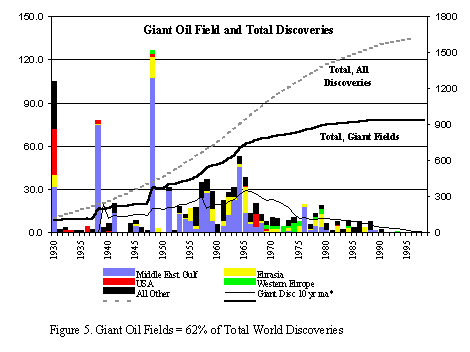
Figure 6. Production of Discovered World Oil Reserves. This is the present decline cycle of all known reserves. The area under the curves represents the total amount of reserves. Hence, an increase of the peak production would result in a steeper decline rate, as the amount of known reserves is fixed. This graph provides the minimum case for supply side crude estimates and is the model presented by Campbell in his “Oil Crises” scenario. I consider this to be the lower limit of future production, as production from new reserves should be considered.

Supply from Future Reserves
Figure 7. Ideal Depletion of a 1 Billion Barrel Oil Field. This is an idealized scenario for production and is used later in this report to make production curves for “yet-to-find” oil. This curve shows production for a 30 year production cycle, used in order to establish a best case scenario of production. Oil production begins in the second year following discovery. In reality, a 50 year cycle would be more appropriate since the oil found may not be in a single pool, may need additional development (long pipelines) which delay first production, or may have reservoir properties not amenable to fast production.

Figure 8. Discovery Distribution for Optimistic Scenario. This is the future discovery schedule for the anticipated 183 billion barrels of oil. These discoveries are scheduled to occur rather simultaneously in all regions, and rather early, peaking at 14 billion barrels per year in year 2003. This accelerated schedule serves to define the limit for the best case depletion scenario.
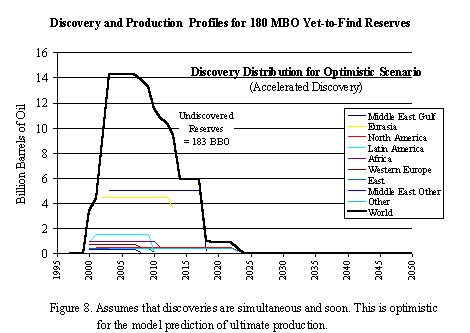
Figure 9. Future Production from Undiscovered Reserves. This is a calculation of expected production based on the ideal production profile of figure 7 and the accelerated discovery schedule of figure 8. This chart shows the yearly and cumulative production generated from the calculation of these two parameters. This is the quickest scenario that the discovery of the worlds remaining reserves could be brought to production. Delays in either discovery or production will serve to shift these curves to the right, but total production would be the same.
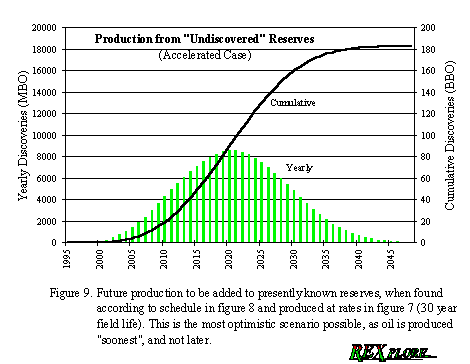
Figure 10. Model for Depletion of World Oil Reserves. Historic production is projected forward to year 2050 for minimum and maximum cases. The minimum, shown in green, accounts for known oil reserves only. The maximum case, shown in red, accounts for production which includes “yet-to-find” reserves, discovered and produced at the maximum rates possible. Actual production in the future will lie between these two curves. Also, the actual decline rate may be flatter, in which case peak production will be lower.
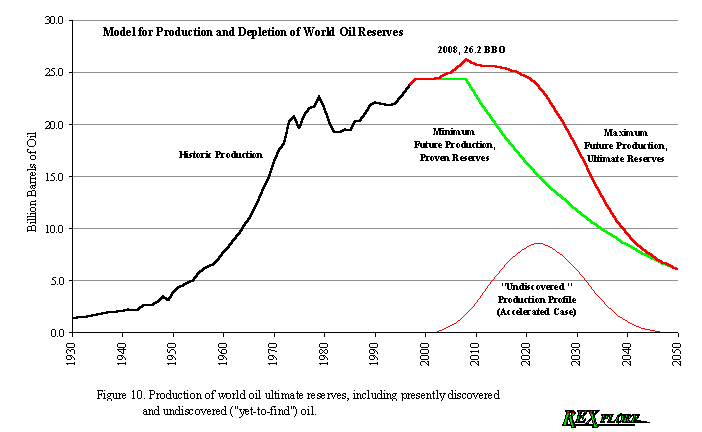
Oil Prices and World Economics
Figure 11. Relationship between Crude Oil Prices and the Consumer Price Index (CPI) in the USA. There is a direct relationship between crude oil prices and inflation, as shown on this chart. This suggests rather serious consequences for the future as supplies decrease, which will occur at some time between 2004 and 2020. Long before the “crises” stage of world oil depletion, increased oil prices, caused by slight constrictions in the supply-demand ratio will cause inflation increases in the US and world economy. Present and historic federal bank policies have favored increases in interest rates in order to fight inflation (generally thought to be caused by “hot” economic expansion and labor shortages). This type of cure-all will also dampen oil sector investments – but at the time they are needed most, providing double-trouble for the inflationary problem. This will further reduce oil discovery and production, adding additional burden to the supply problem, thus creating higher oil prices, additional inflation, etc.
There is no traditional business solution for this problem. Supply is fixed.
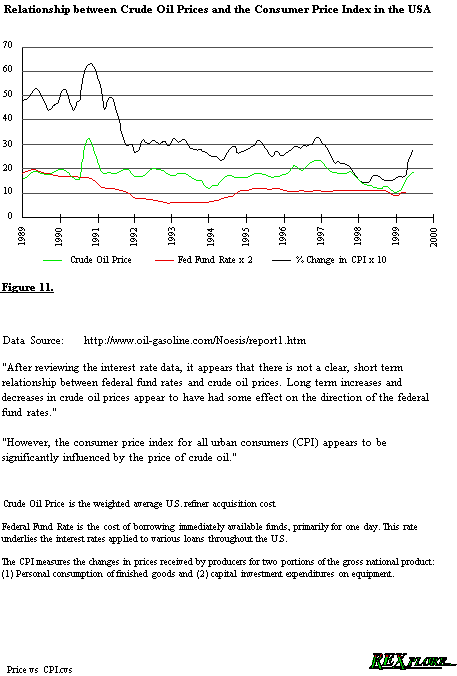
Figure 12. Future World Oil Prices. All prices are in 1999 fixed U.S. dollars. There is no accounting for inflation in this model.
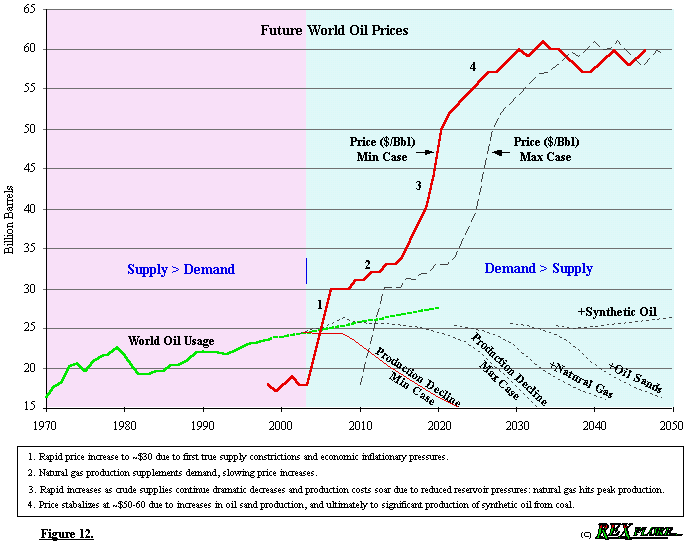
I anticipate that oil prices will rise rather quickly once the slightest supply constriction is perceived, starting before 2005, and possibly as soon as 2002. The accompanying inflationary pressures will hurt businesses other than the oil sector. Costs for the oil sector will remain relatively fixed initially, except for labor costs. Stock markets will make their traditional response to inflation, with the exception of oil companies.
Other energy sources will substitute partially for oil at some price. Natural gas reserves will help, but serious pipelines will need to be built, and this will take time. Oil sand deposits certainly become economic at some price, but not below $30 per barrel minimum, and preferably $40, based on my own experience in the Canadian provinces. Synthetic oils manufactured from coal become viable substitutes at around $60 per barrel, based on the experience gained by German engineers during WW2. These energy substitutes will keep oil prices bound within “reasonable” ranges, at $30 minimum but probably nearer to $60 per barrel as real supply restrictions are realized.
SUMMARY
The historic and present cycle of crude oil production has always been a regime of supply greater than demand as large fields of cheaply produced oil (i.e., free flowing) have been readily available. Production from these fields has large impacts on supply for at least 20 years after their discovery. Though the discovery of new reserves has tapered to insignificant amounts in the last decade, the production response to this is not yet generally perceived because “pump prices” remain flat. This is the result of previous discoveries which are now at their zenith.
The world is definitely entering an era in which demand will be greater than supply. The only question is when, and is anticipated to be between year 2004 and 2020 by this report; but rather sooner than later, as the later date involves quite optimistic variables. Additional petroleum production from natural gas, oil sands and synthetic crude will delay or resolve future supply problems, but not at current prices of $18 per barrel. Rather, prices of $30 per barrel are anticipated immediately upon first acknowledgement by oil futures traders of real supply constraints. Subsequent inflationary pressures and increased production declines will quickly force prices to near $60 per barrel, at which time significant production from alternatives is feasible.
There are three important things to note. First, the oil industry is perceived as having sent out this supply crises alarm several times already. As a result, the public is somewhat insulated from these warnings, including federal policy makers. I anticipate that tax and investment policies during the transition to “supply” economics will exaggerate the coming problem as economists continue to try and stimulate the non-energy business sector as it has traditionally done. A better solution would be to stimulate the energy sector early through tax and investment incentives, thus promoting a stable transition.
A second point worth considering relates to the future increase in costs of world production. This point is often overlooked, as it is difficult to evaluate on a macro-economic scale. However, an analogy for a single oilfield is sufficient to understand the future costs of world production. Initial production from new oilfields encounters virgin pressures and these wells flow oil naturally, at prices around $1 per barrel for direct operating costs (without transportation). Declining reservoir pressure due to oil production eventually requires artificial lift to raise oil to the surface, with costs in the $3 to $5 per barrel range. These costs continue to increase as concurrent water production (and disposal) increases and water eventually becomes 99% of the total produced fluid before the oil field is abandoned. Additional oil may be recovered through secondary techniques, but these costs are around $8 per barrel, minimum, and consume about 20% of the energy, or crude, produced. All fields are produced in this manner, and costs are directly related to reservoir pressure.
World production today is dominated by the Middle East Gulf region which has a large part of its reserves in fields that still have high reservoir pressures, and as a result production costs, with transportation, are less than $5 per barrel – currently. This will change as reservoir pressures naturally decline due to production. The impact of this is far greater than “future production forecasts” imply, as a world with Saudi Arabia producing from artificial lift is quite different than one in which Saudi Arabia produces from free flowing wells – though the “remaining reserves” might seem significant. The immediate impact is that threats of $5 per barrel oil will no longer be realistic if all producers create deficits with temporary overproduction. Thus, the floor price for crude oil will continue to increase.
The point of this long explanation is that total reserves numbers are misleading – as they promote a view that supply will be fine until the day the last drop of oil is produced – and on that day, we have a problem. Rather, we should be aware that average world reservoir pressures are declining naturally, and operating costs are increasing. These affects will be felt concurrent with actual supply constrictions and will have a dominant impact on future crude prices, particularly the floor prices.
A third point worth mentioning has to do with previous responses to oil supply constrictions. The one example of this occurred from 1974 to 1981, and during this time, oil prices lifted from to $4 to $38 per barrel. In hindsight, this is often regarded as a “panic response”, because in fact macroeconomists have concluded there was no real shortage. Whether or not this is true, I regard the period of a good example of the oil price volatility to be expected when real supply constrictions do occur.
“He who produces last makes the most money” will be the doctrine of the future, though it would hardly seem that anyone gives any thought to this idea. This concept seems contrary to modern business principles of valuation based on net present value, but this is only a result of using flat oil price forecasts far into the future.